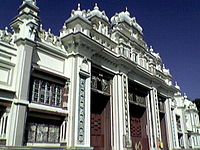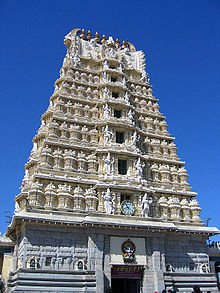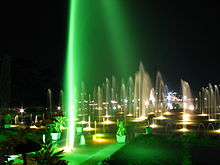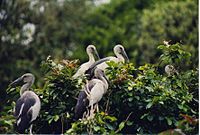Mysore Palace : is a palace situated in the city. It was the official residence of the former royal family of Mysore, and also housed the durbar (royal offices).The term "Palace of Mysore" specifically refers to one of these palaces, Amba Vilas.
|
|
| Jaganmohan Palace : was built in the year 1861 by Krishnaraja Wodeyar III in a predominantly Hindu style to serve as an alternate palace for the royal family. This palace housed the royal family when the older Mysore Palace was burnt down by a fire. The palace has three floors and has stained glass shutters and ventilators. It has housed the Sri Jayachamarajendra Art Gallery since the year 1915. The collections exhibited here include paintings from the famed Travancore ruler, Raja Ravi Varma, the Russian painter Svetoslav Roerich and many paintings of the Mysore painting style. |  |
| Chamundi Hills is close to the palace city of Mysore. Its average elevation is 1,000 metres. A panoramic view of the city is seen from the top of the hills. Among other landmarks, you can see the racecourse, the Lalitha Mahal palace, Mysore Palace, Karanji and Kukkarahalli lakes. At dusk, the view of the city is especially beautiful, and on Sunday evenings and during the Mysore Dasara festival, the illuminated Mysore Palace glitters like gold. |  |
| St. Philomena's Church : is a church built in the honour of St. Philomena in the city of Mysore. It was constructed in 1956 using a Neo Gothic style and its architecture was inspired by the Cologne Cathedral in Germany In 1926, Thamboo Chetty who was a secretary to the Maharaja of Mysore Nalvadi Krishnaraja Wodeyar obtained a relic of the saint from Peter Pisani, Apostolic Delegate of the East Indies This relic was handed over to Father Cochet who approached the king to assist him in constructing a church in honour of St. Philomena The Maharaja of Mysore laid the foundation stone of the church on 28 October 1933. In his speech on the day of the inauguration, the Maharaja is quoted to have said: The new church will be strongly and securely built upon a double foundation — Divine compassion and the eager gratitude of men.. The construction of the church was completed under Bishop Rene Fuga's supervision. The relic of St. Philomena is preserved in a catacomb below the main altar. | |
| Lalitha Mahal: is the second largest palace in Mysore. It is located near the Chamundi Hills, east of the city. The architect of this palace was Mr E W Fritchley. The palace was built by Krishnaraja Wodeyar IV in the year 1921 for the exclusive stay of the Viceroy of India The palace is pure white in colour and is built in the style of Italian palazzo with twin Ionic columns and domes. It also has a sprawling terrace and landscaped gardens. | |
|
|
| Mysore Zoo : one of the oldest and most popular zoos in India. Located on the outskirts of Mysore, the zoo is home to a wide range of wild species. The official name for the zoo is Shri Chamarajendra Zoological Gardens, though it is known commonly by its shortened name. Mysore Zoo is one of the city’s most popular attractions. It was established under royal patronage in 1892, making it one of the oldest zoos in the world. | |
| Brindavan Gardens is a show garden that has a beautiful botanical park, full of exciting fountains, as well as boat rides beneath the dam. Diwans of Mysore planned and built the gardens in connection with the construction of the dam. Display items include a musical fountain. Various biological research departments are housed here. There is a guest house for tourists. It is situated at Krishna Raja Sagara (KRS) dam. |  |
| Srirangapatna : (also spelt Srirangapatna; anglicized to Seringapatam during the British Raj) is a town, situated a mere 13 km from Mysore city .The entire town is enclosed by the river Kaveri to form an island . The town takes its name from the celebrated Ranganathaswamy temple which dominates the town, making Srirangapattana one of the most important Vaishnavite centers of pilgrimage in south India. Srirangapattana became the de facto capital of Mysore under Hyder Ali and Tipu Sultan. Other attractions include the Jumma Masjid (a Mosque) and the Daria Daulat Gardens. The Karighatta (Black Hill) and its temple of Lord Srinivasa is situated a few kilometres from the town. The deity is that of Kari-giri-vasa (one who resides on the black hill). The famous Nimishambha temple is located in the nearby village of Ganjam. The summer palace of Tipu Sultan is also a very interesting place. |  |
| Bylakuppe : is the location of "Lugsum Samdupling" (established in 1961) and "Dickyi Larsoe" (established in 1969), two adjacent Tibetan refugee settlements, in the west of Mysore district . It consists of a number of small camps/agricultural settlements close to each other, and has a number of monasteries, nunneries and temples in all the major Tibetan Buddhist traditions. Most notable among them are the large educational monastic institution Sera, the smaller Tashilunpo monastery (both in the Gelukpa tradition) and Namdroling monastery (in the Nyingma tradition).Particularly well known among the temples is the spectacular Golden Temple which is also a major tourist spot in the area. |
|
|
|